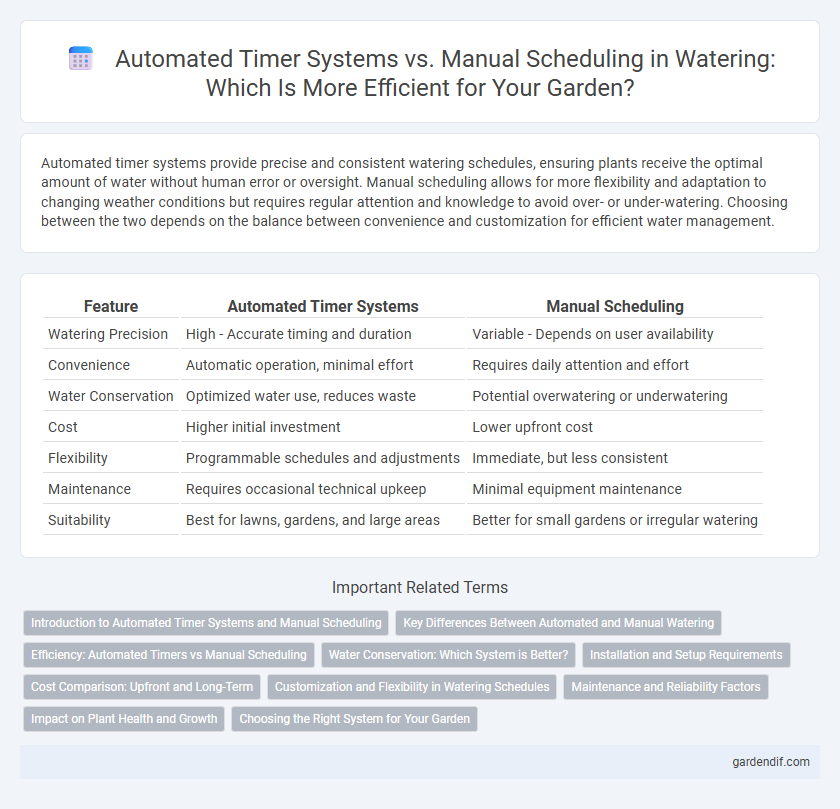
Automated timer systems vs Manual scheduling Illustration
Automated timer systems provide precise and consistent watering schedules, ensuring plants receive the optimal amount of water without human error or oversight. Manual scheduling allows for more flexibility and adaptation to changing weather conditions but requires regular attention and knowledge to avoid over- or under-watering. Choosing between the two depends on the balance between convenience and customization for efficient water management.
Table of Comparison
| Feature | Automated Timer Systems | Manual Scheduling |
|---|---|---|
| Watering Precision | High - Accurate timing and duration | Variable - Depends on user availability |
| Convenience | Automatic operation, minimal effort | Requires daily attention and effort |
| Water Conservation | Optimized water use, reduces waste | Potential overwatering or underwatering |
| Cost | Higher initial investment | Lower upfront cost |
| Flexibility | Programmable schedules and adjustments | Immediate, but less consistent |
| Maintenance | Requires occasional technical upkeep | Minimal equipment maintenance |
| Suitability | Best for lawns, gardens, and large areas | Better for small gardens or irregular watering |
Introduction to Automated Timer Systems and Manual Scheduling
Automated timer systems enable precise control over watering schedules by programming irrigation to activate at specific times, optimizing water usage and plant health. Manual scheduling relies on the user's observation and judgment to determine watering frequency and duration, which can lead to inconsistent watering and potential overuse or underuse of water. Integrating smart timers with weather sensors can further enhance automated systems by adjusting irrigation based on soil moisture and climate conditions.
Key Differences Between Automated and Manual Watering
Automated timer systems provide precise control over watering schedules, enabling consistent irrigation at optimal times without human intervention, which conserves water and promotes healthier plant growth. Manual scheduling relies on user attention and judgment, often leading to irregular watering patterns that can either overwater or underwater plants, increasing the risk of plant stress and water waste. Key differences include automation accuracy, convenience, water efficiency, and the ability to adapt quickly to weather variations, with automated systems typically outperforming manual methods in these areas.
Efficiency: Automated Timers vs Manual Scheduling
Automated timer systems optimize watering efficiency by precisely controlling irrigation schedules based on specific plant needs and weather conditions, reducing water waste and promoting healthier growth. Manual scheduling often leads to inconsistent watering times and durations, increasing the risk of overwatering or underwatering. Advanced automated timers incorporate smart sensors and weather data, ensuring water is applied only when necessary, significantly enhancing resource conservation compared to manual methods.
Water Conservation: Which System is Better?
Automated timer systems optimize water conservation by delivering precise amounts of water at scheduled intervals, reducing human error and preventing overwatering. Manual scheduling often leads to inconsistent watering patterns and increased water waste due to variability in user attention and weather conditions. Smart irrigation technologies integrated with automated timers further enhance efficiency by adjusting watering based on soil moisture and climate data, making them superior for water conservation compared to manual methods.
Installation and Setup Requirements
Automated timer systems require initial installation involving wiring or battery setup, which may demand technical skills and compatibility with existing irrigation equipment. Manual scheduling involves no physical installation, relying instead on user input to set watering times, making it simpler but prone to human error. Automated systems provide consistent watering schedules after setup, while manual scheduling requires ongoing adjustment and oversight.
Cost Comparison: Upfront and Long-Term
Automated timer systems require a higher upfront investment, typically ranging from $50 to $300 depending on features and complexity, while manual scheduling incurs negligible initial costs. Over the long term, automated systems can reduce water consumption by up to 30%, leading to significant savings on water bills and lower maintenance expenses. Manual scheduling often results in inconsistent watering, potentially increasing water waste and higher cumulative costs over time.
Customization and Flexibility in Watering Schedules
Automated timer systems offer precise customization with programmable intervals, durations, and multiple daily cycles, ensuring optimal water usage tailored to different plant needs. Manual scheduling relies on user availability and memory, often resulting in inconsistent watering patterns that can lead to over- or under-watering. Advanced automated controllers provide flexibility through weather-based adjustments and remote management, delivering efficient irrigation without constant supervision.
Maintenance and Reliability Factors
Automated timer systems reduce human error by consistently managing watering schedules, leading to more reliable irrigation with minimal maintenance. Manual scheduling demands frequent adjustments and monitoring, increasing the risk of over- or under-watering due to inconsistent human involvement. Automated systems often include self-diagnostic features and durable components, ensuring long-term reliability and reduced maintenance compared to manual methods.
Impact on Plant Health and Growth
Automated timer systems provide precise and consistent watering schedules, reducing the risk of overwatering or underwatering, which directly supports optimal plant health and growth. Manual scheduling often leads to irregular watering patterns due to human error or forgetfulness, potentially stressing plants and hindering development. Studies show that plants watered with automated systems exhibit higher growth rates and improved resilience compared to those reliant on manual watering.
Choosing the Right System for Your Garden
Automated timer systems offer precise control over watering schedules, ensuring consistent moisture levels that promote healthy plant growth and conserve water. Manual scheduling relies on regular attention and can lead to overwatering or underwatering due to human error or forgetfulness. Selecting the right system depends on garden size, plant types, and lifestyle, with automated timers ideal for busy gardeners seeking efficiency and manual methods suiting those preferring hands-on care.
Automated timer systems vs Manual scheduling Infographic

 gardendif.com
gardendif.com